Come on, Kwintet, be a good sport
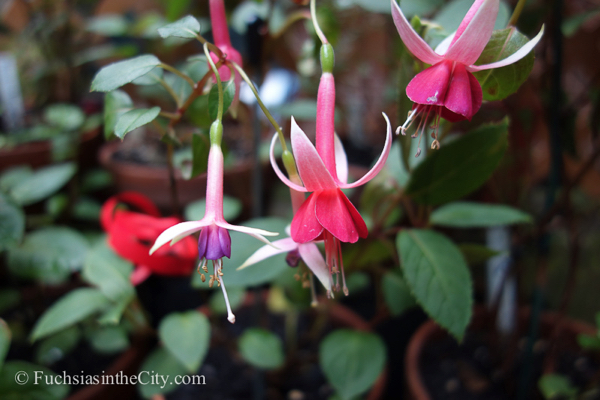
Something funny happened in the garden this morning. No, the squirrels didn’t leave a fruit basket on the back step with a knock and a nice note apologizing for having gnawed off the lily buds by the fence this July. Nor did the leopard slugs suddenly declare that they’ve had their fill of hosta and from now on would be dining solely on the annoyingly nearby silver maples and Ailanthus. No. None of that. There was a fuchsia I didn’t recognize.
I was working my way back and forth the across the pots on the plant steps as I do every morning, watering, cleaning away spent flowers, yellowed leaves, generally checking up on things. When I got to Fuchsia ‘Kwintet’, I stopped. A neighboring fuchsia seemed to have brazenly reached a long branch through ‘Kwintet’ to flower on the other side. Two nice blooms dangled at the end of that branch, but which one? Which fuchsia? It wasn’t a familiar bloom at all. Obviously not ‘Cardinal’, ‘David’, ‘Cotta Vino’, Sunshine’? A bit perplexed, I followed the branch back to… ‘Kwintet’. And back and forth again a couple more times to be sure. Certainly ‘Kwintet.’
‘Kwintet’ has lovely rosy pink blossoms with hints of salmon. Its tubes are fairly long and its sepals arch elegantly upwards. The single corollas tend to flare out attractively into bell shapes. This cultivar came from H. C. van Wieringen, who registered it along with nine of his other hybrids all at once in 1970. Unfortunately van Wieringen seemed to have made all his crosses without recording the parent plants he used. ‘Kwintet’ forms a nice upright, floriferous shrub and appears to be the one of his creations that has become most widely grown. If it has any major drawback, it’s only half hardy and needs a fairly sheltered spot to survive the winter if planted out in the garden.
The pair of unknown flowers that caught my eye are distinctly different from all the others on the plant in a few ways. While still long and elegant, the new blooms are slightly smaller and paler. Their sepals seem to open out horizontally, with a light curve down, and not the strong upwards curl of ‘Kwintet’s’ normal blossoms, The corolla is smaller, almost tiny even, in comparison and remains tighter without opening up with the usual bell-shaped flare. Its color is an attractive lavender with the rosy pink restricted to just the base of the petals. ‘Kwintet’, it seems, has sported.
In botany, a sport is a part of a plant, such as a bud or branch, that shows distinct morphological differences from the rest of it. Sports can show in a number of ways, such as a change in the shape or color of the foliage or the structure of the branches. Or the shape and color of the flowers. Desirable changes, when they occur, can be propagated from cuttings to produce new cultivars retaining the characteristics of the sport, though some might be prone to “revert” to the parent’s original form.
Like most plants, fuchsias occasionally throw sports as well. “White Churchill’ developed from ‘Winston Churchill’. ‘Beacon Rosa’ apparently from ‘Beacon’. Most variegated fuchsias are sports from some parent or other. Time will tell if ‘Kwintet’ has produced a real sport or just a passing fancy. But I’m kind of excited. There hasn’t been a good sport around here in a while. And this one certainly looks interesting if it holds. I’ve marked the branch and will soon be dividing it into several cuttings for propagation. Flower sports also often involve other growth characteristics as well. It’ll be interesting to see how its growth stacks up to its parent’s. Finally, I’ll need to check if ‘Kwintet’ has sported before in a similar way. It happens and there’s little point in maintaining what’s already there. Stay tuned.
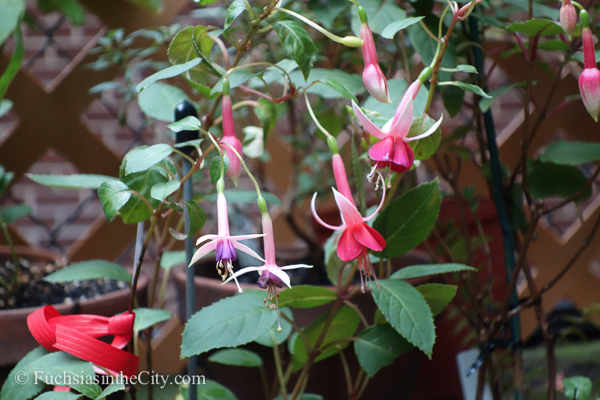
‘Kwintet’s’ normal flowers appear on the right. On the left is the alleged sport.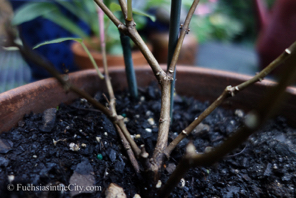
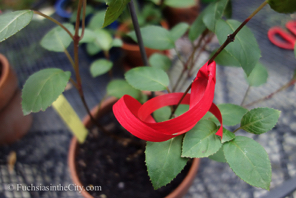
The branch forking to the right is the one on which the sported flowers appeared. I’ve marked it quite prominently to make sure I don’t loose track.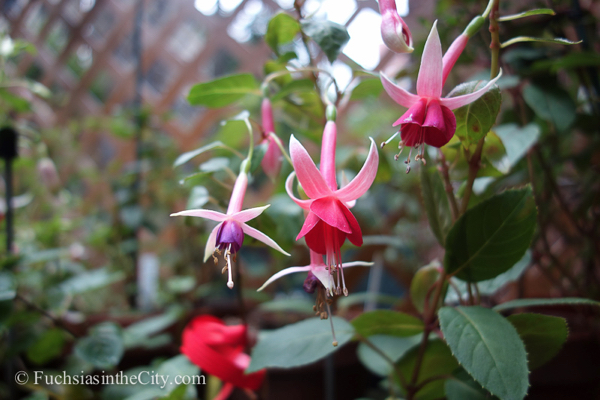
Note the striking differences between the two flowers, especially in the size, shape and color of the corolla and the sepals.